Shaki, Azerbaijan
| Shaki Şəki | ||
|---|---|---|
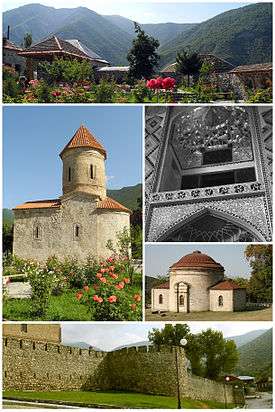
 | ||
| ||
 Shaki Location of Shaki in Azerbaijan | ||
| Coordinates: 41°11′31″N 47°10′14″E / 41.19194°N 47.17056°ECoordinates: 41°11′31″N 47°10′14″E / 41.19194°N 47.17056°E | ||
| Country | Azerbaijan | |
| Government | ||
| • Head of the Executive Power | Elkhan Usubov | |
| Area | ||
| • Total | 9 km2 (3 sq mi) | |
| Elevation[1] | 545 m (1,788 ft) | |
| Population (2012)[2] | ||
| • Total | 63,700 | |
| • Density | 7,100/km2 (18,000/sq mi) | |
| Time zone | AZT (UTC+4) | |
| • Summer (DST) | AZT (UTC+5) | |
| Postcode | AZ5500 | |
| Area code(s) | +994 02424 | |
| Website | Official website | |
Shaki (Azerbaijani: Şəki; until 1968 Nukha, Azerbaijani: Nuxa) is a city in northwestern Azerbaijan, in the rayon of the same name.
Shaki is situated in northern Azerbaijan on the southern part of the Greater Caucasus mountain range, 325 km (202 mi) from Baku. The population is 63,000.
Etymology
According to the Azerbaijani historians, the name of the town goes back to the ethnonym of the Sakas, who reached the territory of modern-day Azerbaijan in the 7th century BC and populated it for several centuries.[3] In the medieval sources, the name of the town is found in various forms such as Sheke, Sheki, Shaka, Shakki, Shakne, Shaken, Shakkan, Shekin.
History
Antiquity
There are traces of large-scale settlements in Shaki dating back to more than 2700 years ago. The Sakas were an Iranian people that wandered from the north side of the Black Sea through Derbend passage and to the South Caucasus and from there to Asia Minor in the 7th century B.C. They occupied a good deal of the fertile lands in South Caucasus in an area called Sakasena. The city of Shaki was one of the areas occupied by the Sakas. The original settlement dates back to the late Bronze Age.
Shaki was one of the biggest cities of the Albanian states in the 1st century. The main temple of the ancient Albanians was located there. The kingdom of Shaki was divided into 11 administrative provinces. Shaki was one of the important political and economic cities before the Arab invasion. But as a result of the invasion, Shaki was annexed to the third emirate. An independent Georgia principality, Hereti, was established in times when the Arab caliphate was weak.[4] The city was also ruled by the Kingdom of Georgia, the Atabegs of Azerbaijan and the Khwarazmian Empire, before the Mongol invasion.
Feudal era

After the collapse of the Hulagu Khan's rule in the first half of the 14th century, Shaki gained independence under the rule of Sidi Ahmed Orlat.[5] In the early 1500s, Safavid king Ismail I (r. 1501—1524) conquered the area, but the town continued to be governed by its hereditary rulers, under Safavid suzerainty.[6] Ismail's son and successor Shah Tahmasp (r. 1524—1576) put an end to this, and in 1551, he appointed the first Qizilbash governor to rule the town.[7] Safavid rule was twice briefly interrupted by the Ottomans between 1578–1603 and 1724-1735. Shaki Khanate was established in 1743, during the reign of Nader Shah, and was one of the strongest feudal states among the Caucasian khanates. During existence of Shaki khanate, the local population of the city was engaged in silkworm breeding, craft and trade.[4] As a result of a flood in the river Kish, the city of Shaki was partially ruined and the population was resettled in the present day city.[8]
Modern era
The area was fully annexed by Russia by the Treaty of Gulistan in 1813 and the khanate was abolished in 1819 and the Shaki province was established in its place. Shaki province was merged with provinces of Shemakha, Baku, Susha, Lankaran, Derbent and Kuban in 1840 and Caspian Oblast was created. At same time Shaki was renamed as Nuha. The oblast was dissolved in 1846 and it was raion center of Shemakha Governorate. After the earthquake in Shemakha in 1859, the governorate was renamed as Baku Governorate. On 19 February 1868, raion of Nuha was passed to newly created Yelizavetpol Governorate with one of Susha. After founding of USSR, it was center of Nuha raion. Its one was abolished on 4 January 1963 and was bounded to one of Vartashen. Nuha one was founded again in 1965 and finally city and raion regained traditional name in 1968.
During its history, the town saw devastation many times and because of that, the oldest historic and architectural monuments currently preserved are dated to only the 16th-19th centuries. For many centuries, Shaki has been famous for being the center of silkworm-breeding. Originally located on the left bank of the river Kish, the town sat lower down the hill, however Shaki was moved to its present location after a devastating flood in 1772 and became the capital of Shaki Khanate. As the new location was near the village of Nukha, the city also became known as Nukha, until 1968 when it reverted to the name Shaki.[9]
Geography
Shaki is surrounded by snowy peaks of the Greater Caucasus, in some places reaching 3000–3600 m. Shaki's climate includes a range of cyclones and anticyclones, air masses and local winds. The average annual temperature in Shaki is 12 °C. In June and August, average temperature varies between 20 and 25 °C.
The mountain forests around the area prevent the city from floods and overheating of the area during summer. The main rivers of the city are the Kish and Gurjhana. During the Soviet rule of Azerbaijan, many ascended to Shaki to bathe in its prestigious mineral springs.
Demographics
Religion
A home to ancient Caucasian Albanian churches, religion is highly important to the people of Shaki due to its historical religious diversity. There are many churches and mosques in the city. Some churches such as the Church of Kish in the vicinity of Shaki are thought to be approximately 1,500 years old.[10] The Khan's Mosque, Omar Efendi Mosque and Gileili Minaret are considered important places of worship in the city.[11]
Economy
During 1850-70, Shaki became international silk production centre.[12] More than 200 European companies opened offices in the city, while silkworms to the tune of 3 million roubles were sold to them in a year.[12]
Shaki possesses a small silk industry and relies on its agricultural sector, which produces tobacco, grapes, cattle, nuts, cereals and milk. The main production facilities of Shaki are the silk factory, gas-power plant, brick factory, wine factory, sausage factory, conserve factory, and a dairy plant with its integrated big scale Pedigree Dairy Farm.
Tourism and shopping
In 2010, Shaki was visited by 15,000 foreign tourists from all around the world.[13]
Culture
Shaki has one of the greatest density of cultural resources and monuments that include 2700 years of Azerbaijani history. The city boasts a lot of houses with red roofs. In pop culture, probably the most famous feature of Shakinians are their nice sense of humour and comic tales.[14] Shaki's comic tales hero Hacı dayı (Uncle Haji) is the subject of nearly all jokes in the area.[15][16]
Shaki has always played a central role in Azerbaijani art and more generally in the art and architecture of Azerbaijan. Under the name of Nukha, the city is the scene of much of the action in Brecht's play The Caucasian Chalk Circle.[17]
Architecture
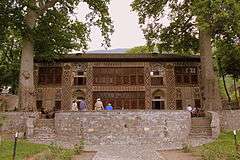
Architecture in Shaki has largely been shaped by Shaki's history. It goes back to a time, when it was a market centre on the Silk Road, linking Dagestan, Russia to the northern trade routes through the Caucasus.[18]
The city's central and main open city squares are dominated by two Soviet towers.[11] Many public places and private houses in Shaki are decorated with shebeke, a wooden lattice of pieces of coloured glass, held together without glue or a single nail.[19] The technique is complex and known only to a few artisans who pass their meticulous craft from generation to generation.[19]
The Palace of Shaki Khans which was a summer residence of Shaki Khans, still remains one of the most visible landmarks of Shaki. Constructed in 1762 without a single nail is one of the most marvelous monuments of its epoch.[11] Displayed within the palace are Azerbaijani Khanate-era artifacts, as well as displays of the art scene, considered to be among the finest in the world.[20][21]
The Shaki Castle which was built by the founder of the Shaki Khanate Haji Chelebi Khan (1743–1755), near the village of Nukha on the southern foothills of the Caucasus. The fortress walls are close to a thousand and two hundred meters long and over two meters thick.[22] Protected by numerous bastions, the fortress is entered by two main gates from the north and south. At the height of the khanate, the fortress contained a gated palatial complex and public and commercial structures of the city, while the residential quarter was situated outside its walls. It was restored extensively between 1958 and 1963.[23] Many years Shaki fortress safeguarded approaches to the city, the acts of bravery by its defendants of fight with foreign oppressors had been written in many history books. In Leo Tolstoy's well-known Hadji Murat novel, Shaki fortress had selected as place of events.[14]
Cuisine

Perhaps the best-known aspect of Shaki cooking is its rich sweet dishes. Shaki is traditionally held as the home of special type of baklava, called Shaki Halva.[24] Others include nabat boiled sugar and sweet pesheveng.[14]
Shaki also has some famous dishes, including girmabadam, zilviya, piti, a stew created with meat and potatoes and prepared in a terracotta pot.[14][24]
Language
The city of Shaki has developed its own dialect of Azerbaijani language, which is mainly spoken in the city, and the region of Shaki Rayon. Residents of city are known for their cheerful intonation of the words.
Museums
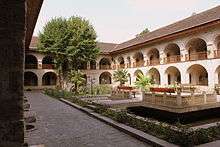
Shaki hosts a wealth of historical museums and some of the most important in the country. The Shaki History Museum is one of the main museums, considered one of the most important for artifacts of the Khanate period.[11]
As of the 18th century, five big Caravanserais (Isfahan, Tabriz, Lezgi, Ermeni and Taze) were active in Shaki but only two of them have survived.[8] The upper and lower Caravanserais were built in the 18th century and used by merchants to store their goods in cellars, who traded on the first floor, and lived on the second. Both Caravanserais includes view of all convenience and safety of merchants and their goods.[11]
Music and media
The city is home of annual Mugham Festival and Silk Road International Music Festival.[25]
The regional channel Kanal-S, newspapers Shaki and Shakinin Sasi are headquartered in the city.[26]
Transport
Public transport
Shaki has a large urban transport system, mostly managed by the Ministry of Transportation.
Education
There are 29 primary schools and 20 secondary schools functioning in the city.[27]
Notable residents
Some of the city's many prestigious residents include: Fatali Khan Khoyski, prime minister of Azerbaijan Democratic Republic, Ahmadiyya Jabrayilov, activist of the French Resistance, poet Bakhtiyar Vahabzadeh, composer Jovdat Hajiyev, film director Rasim Ojagov, actor Lutfali Abdullayev, religious leader Mahammad Hasan Movlazadeh Shakavi and others.
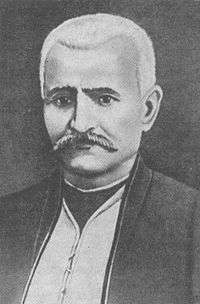 Mirza Fatali Akhundov, founder of materialism and atheism movement in Azerbaijan and modern Iranian literature, as well as one of the forerunners of Iranian nationalism
Mirza Fatali Akhundov, founder of materialism and atheism movement in Azerbaijan and modern Iranian literature, as well as one of the forerunners of Iranian nationalism Shakili Alasgar, mugham performer.
Shakili Alasgar, mugham performer.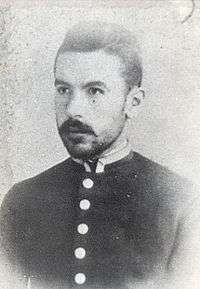 Abdulali bey Amirjanov, was member of Azerbaijani National Council.
Abdulali bey Amirjanov, was member of Azerbaijani National Council. Mahammad Hasan Movlazadeh Shakavi, the first scholar who translated Quran into the Azerbaijani language.
Mahammad Hasan Movlazadeh Shakavi, the first scholar who translated Quran into the Azerbaijani language.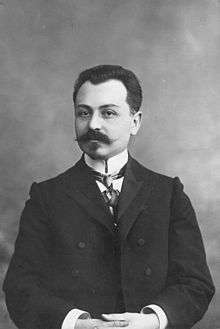 Fatali Khan Khoyski, the first Prime Minister of the independent Azerbaijan Democratic Republic.<ref name=president>"Presidential Library. Fatali Khan Khoyski" (PDF). p. 70. Retrieved 2010-07-09.
Fatali Khan Khoyski, the first Prime Minister of the independent Azerbaijan Democratic Republic.<ref name=president>"Presidential Library. Fatali Khan Khoyski" (PDF). p. 70. Retrieved 2010-07-09.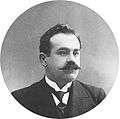 Salman Mumtaz, Azerbaijani literary scholar and poet.
Salman Mumtaz, Azerbaijani literary scholar and poet.
International relations
Twin towns — Sister cities
Shaki is twinned with the following cities:
Gallery
 Ancient house in Shaki
Ancient house in Shaki Shaki House of Culture
Shaki House of Culture Front view of Albanian church
Front view of Albanian church One of the old streets of Shaki
One of the old streets of Shaki Door of Shaki Khan Palace
Door of Shaki Khan Palace A 6th-century Caucasian Albanian church
A 6th-century Caucasian Albanian church View of Shaki's Karavansarai
View of Shaki's Karavansarai Omer Efendi Mosque
Omer Efendi Mosque- Shaki fortress
- Khan's Palace of Shaki
- House of Shakikhanovs
- Sheki Caravanserai
- Ashagi Caravanserai
- House of Farhadbayovs
- House of Alijanbayovs
- Minaret of Friday mosque
.jpg) Ömər Əfəndi mosque
Ömər Əfəndi mosque- Ağvanlar bath
- Undergraund bath in Shaki
 Former Armenian church in Shaki
Former Armenian church in Shaki
See also
References
- ↑ "Shaki, Azerbaijan Page". Retrieved 2008-07-03.
- ↑ World Gazetteer: Azerbaijan – World-Gazetteer.com
- ↑ "Narinqala: Shaki's History". Retrieved 6 December 2010.
- 1 2 "Sheki history". Azerbaijan Tour Agency. Retrieved 7 December 2010.
- ↑ "Shaki", in Historical Dictionary of Azerbaijan, 1999, p. 117
- ↑ Nasiri, Ali Naqi; Floor, Willem M. (2008). Titles and Emoluments in Safavid Iran: A Third Manual of Safavid Administration. Mage Publishers. p. 279. ISBN 978-1933823232.
- ↑ Nasiri, Ali Naqi; Floor, Willem M. (2008). Titles and Emoluments in Safavid Iran: A Third Manual of Safavid Administration. Mage Publishers. p. 279. ISBN 978-1933823232.
- 1 2 Sharifov, Azad. "Paradise in the Caucasus Foothills". azer.com. Retrieved 7 December 2010.
- ↑ Şəki Şəhərinin Tarixi (Azerbaijani)
- ↑ "Norwegians Help Restore Ancient Church". Azerbaijan International. Winter 2000. Retrieved 2010-12-07.
- 1 2 3 4 5 "Azerbaijan24: Sheki". Retrieved 6 December 2010.
- 1 2 Aliyarli, Suleyman. "The Great Silk Road and trade between the Caspian and Europe". www.visions.az. Retrieved 13 November 2014.
- ↑ "Зарегистрировано увеличение туристического потока в Шекинский район". 1news.az. Retrieved 17 July 2011.
- 1 2 3 4 "SHEKİ DISTRICT". Retrieved 7 December 2010.
- ↑ "Təhsilimizin Hacı dayısı". Gunbaki. Retrieved 7 December 2010.
- ↑ Ismayilli, Sevda. "Novella Cəfəroğlu: Referendumdan sonra elə gülürəm". azadlig.org. Retrieved 7 December 2010.
- ↑ Gantz, Jeffrey. "On Chelsea waterfront, a moving story of motherhood". www.bostonglobe.com. Retrieved 13 November 2014.
- ↑ "CNN stops at Shaki City on the Silk Road". teas.eu. Retrieved 13 November 2014.
- 1 2 Bayramova, Jeyran. "SHEKI'S MYSTERIES – STAINED GLASS AND THE SWEETEST HALVA". www.visions.az. Retrieved 13 November 2014.
- ↑ "GENERAL INFORMATION ON AZERBAIJANI CULTURE". Embassy of Azerbaijan in Kuwait. Retrieved 6 December 2010.
- ↑ Gink, Kalory (1979). Azerbaijan: Mosques, Turrets, Palaces. Corvina-Kiado. pp. 60–61.
- ↑ Mammadov, Farid (1994). Azerbaijan: Fortresses-Castles. Iterturan Inc. pp. 195–201.
- ↑ "Fortress and Summer Residence of the Khans of Sheki". Archnet.org. Retrieved 6 December 2010.
- 1 2 "SHAKI : WHAT TO EAT IN SHAKI". guidepicker.com. Retrieved 7 December 2010.
- ↑ "5th International music festival "Silk Road" to open in Shaki". www.news.az. Retrieved 15 November 2014.
- ↑ "Radio-TV yayımı" (in Azerbaijani). Retrieved 13 November 2014.
- ↑ "Şəki rayonu ümumi təhsil müəssisələri və internat məktəbi haqqında". www.sheki-ih.gov.az (in Azerbaijani). Retrieved 12 November 2014.
- 1 2 3 4 5 6 7 "Qardaş şəhərlər". www.sheki.tv (in Azerbaijani). Retrieved 13 November 2014.
- ↑ "Shaki Gabrovo". www.azembassy.bg. Retrieved 13 November 2014.
- ↑ Любовью народа увековеченный (PDF) (in Russian). p. 1. Retrieved 13 November 2014.
- ↑ Шеки и Слуцк стали городами-побратимами. www.1news.az (in Russian). Retrieved 13 November 2014.
- ↑ "Shaki 'fraternizes' with another city". www.news.az. Retrieved 13 November 2014.
- ↑ AzerNews. "Sheki, Colmar ink friendship charter". AzerNews. Retrieved 2016-05-03.
External links
| Wikimedia Commons has media related to Shaki. |
| Wikivoyage has a travel guide for Sheki. |
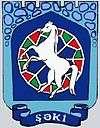
_(semi-secession).svg.png)